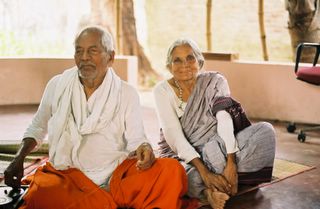How Much Does A House Cost?
Peggy Burns, Executive Director of Friend of LAFTI Foundation (www.friendsoflafti.org ) is often asking me how much one of the new LAFTI houses really costs (so that she can ask you for all or part of it!) And my answer has always been, “depends”.
Well, the answer, as you shall see, is still “depends”, but now I can put real numbers to the answer “depends” on what.
I am holding in my hand the official design specifications for the houses to be built, from the People’s Architecture Commonweal, Ltd.. Each consists of a main house and a detached bath house. The main house is 367 square feet and consists of three rooms and a verandah. There are two windows, one each on the front and side. The house itself is 18’7½” wide, and 16’9” deep. One room has built-in shelving. There is a door to the back, and the plinth is large enough to accommodate two additional rooms in the future. There is an open service yard. The detached bath house with toilet is 34 square feet. A leach pit will be shared by two to four houses. So, overall, the house is 401 square feet. Each house will have a tiled roof. Looks like a palace to me, and I’m moving in tomorrow!
Now for the cost. Complete – RS. 199,174, or, as I now kid Krishnammal with my new monetary measure system, two Nanos (two lakh, each Nano costs 1 lakh, or 100,000 rupees) – or at current rate of exchange, $4.425. Plus the cost of a biosand water filter.
But wait – that is if we paid for everything. Of this cost, RS. 136,500 (around 2/3rds) is for materials, RS. 63,000 (1/3rd) for labor. Much of the labor will be contributed by the villagers themselves, and Krishnammal’s army of masons and carpenters. So reduce the cost of labor by half. Bricks are estimated at RS. 12,400, but I believe that is the cost if purchased at market. We plan to make bricks, which will still require inputs like cement, but figure to reduce that cost by half. The roofing tiles (RS. 17,400) are (it is assumed) to be donated by the Oil and Natural Gas Board, as they have been in the past.
So the real cash cost to LAFTI of a house is RS. 144,000 (one Nano, 44,000 or $3,200 give or take 10%.) Krishnammal remains hopeful (actually emphatic) she will convince the state government to contribute RS. 55,000 per house, which will reduce the cost below that of a Nano, to RS. 89,000, $1,950.
So poor Peggy is reduced to having three answers to her question: $1,950 (optimistic); $3,200 (current state of affairs until the state government kicks into the pot); or $4,425, which is the stated architectural cost. Plus the cost of a biosand water filter.
Our green bag is open for business! (And remember, it is still only a dime a brick, or $1 a day to support a villager to work at the brickmaking machine.)
P.S. I forgot to add that each woman beneficiary of the houses has saved RS. 5,000 ($112) toward the cost of their home. Not a lot, (though it is a huge amount for them), but with a thousand women already having done so, it provides LAFTI with working capital of $112,000.


0 Comments:
Post a Comment
<< Home